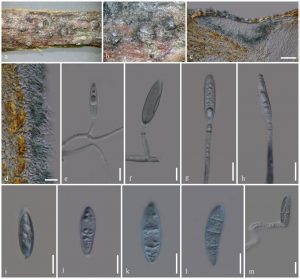Lamproconium desmazieri (Berk. & Broome) Grove [as ‘desmazierii’], British Stem- and Leaf-Fungi (Coelomycetes) (Cambridge) 2: 321 (1937)
Index Fungorum number: IF 251819
Saprobic on dead branch of Tilia sp. Asexual morph: Conidiomata 750–1000 × 500–550 μm diam., pycnidial, solitary, partly immersed in host tissue, uniloculate, dark blue, with a raised centre. Pycnidium 50–70 μm, with multi-layered wall, thin at inner layer, hyaline, comprising wall cells of textura angularis. Paraphyses interspersed with conidiophores. Conidiophores 50–115 μm, arising from the innermost wall layer at the base of pycnidium, filiform or cylindrical, pale bluish to hyaline, septate, branched, smooth-walled. Conidiogenous cells cylindrical to subcylindrical, annellidic, percurrently proliferating up to 3–4 times, with flared periclinal thickenings in the collarette zone, colourless to olivaceous, smooth-walled. Conidia 22–28.5 × 8–10 μm (x̅ = 25.25 × 9 μm, n = 30), fusiform, ellipsoid, infrequently slightly curved, 1-3 septate, initially hyaline, bluish to glistening dark blue at maturity, narrowly rounded at ends, smooth-walled. Sexual morph: Undetermined.
Material examined – Italy, on dead branch of Tilia sp., Erio Camporesi, IT3069 (MFLU 16-2481), living culture (MFLUCC 17-1401).
GenBank numbers – ITS: MW159906, LSU: MW160135.
Known distribution (based on molecular data) – Russia (Norphanphoun et al. 2016).
Known hosts (based on molecular data) – Telia species (Norphanphoun et al. 2016).
Notes – Our strain MFLUCC 17-1401 forms well-supported clade within the Lamproconium desmazieri. Lamproconium desmazieri forms aseptate conidia (Norphanphoun et al. 2016) while conidia in our isolate are 1–3-septate.
Fig – Lamproconium desmazieresi (MFLUCC 17-1401, a new geographic and host record). a–b Conidiomata on host. c Cross section of a conidioma. d Peridium and raised host tissue. e–h Conidiogenous cells with attached conidia (note: annellations at the tip of the conidiogenous cell). i–l Mature conidia. m Germinating conidium.

